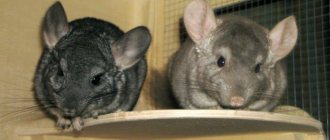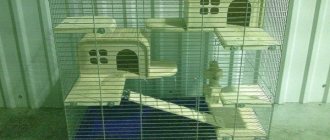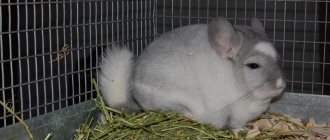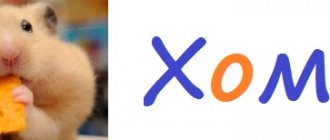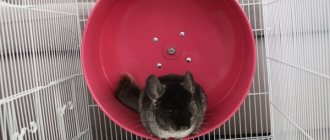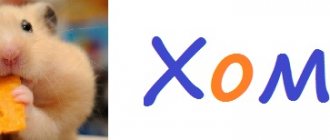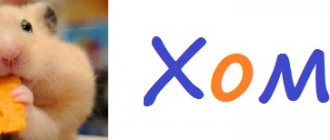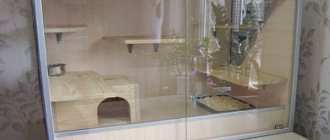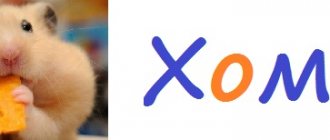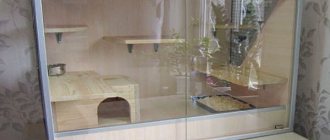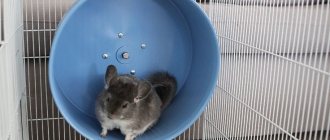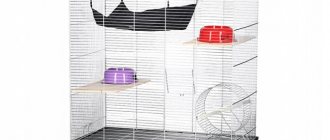- home
- Chinchilla
- Nutrition
04/04/2019 The health of chinchillas is the result of proper care. The delicate stomach of these creatures can easily be damaged by inappropriate nutrition, or even disabled.
Before getting a furry pet, it is recommended to familiarize yourself with information about the diet of these fauna representatives, nutrition rules and types of food.
Types of food for chinchillas
In natural conditions, chinchillas live among poor vegetation that suffers from droughts. Their food is not known for its variety, and is based on cereals, cacti and beans, grass sprouts, moss and bark.
The needs of domesticated chinchillas are similar to those of their wild counterparts. Therefore, food should not differ much from what is found in nature.
Factory-made food for chinchillas is developed with the rodent’s need for useful components. It is divided into 3 types:
- Complex: concentrated and granular mixtures with cereals, dried fruits, beans and nuts.
- Hay from forbs and stems of cereals (clover, alfalfa).
- Greens: sprouted oats and wheat, sprouts of medicinal herbs.
Concentrated (complex) food is an essential component of the animal’s diet, since greens and hay serve as food additives.
Attention: other rodent foods are not suitable for chinchillas because they contain inappropriate ingredients.
Composition of premium food and how they differ.
To understand why you pay a lot of money when you buy premium food, you need to carefully read the composition. In this case, premium food from Fiory was used. Almost all premium food is supplied only in granules.
- The basis is taken from useful herbs: Timothy grass, medicinal dandelion, fescue, ryegrass, plantain, common gum, nettle leaves, thyme, shepherd's purse, two types of clover, meadowsweet, verbena, common fragrant spikelet, ragweed, plantain leaves, kupir, foxtail , Bermuda grass, peas, chicory, fennel.
- Quartz sand for grinding teeth
- Mineral supplements, yeast feed and yeast cell walls, chicory inulin, fructose, nucleotides, substances containing omega 3 and omega 6, beta glucan,
- As a result, we get the content of vitamins A, D3, E, B1, B2, B6, B9, B12 and several more.
- Balanced amount of fat, fiber and protein. 12% protein, only 3% fat, 43% fiber, 8% ash.
Unfortunately, this food states that it contains 0% calcium and phosphorus, which means you will have to independently add components that contain them to the diet. It turns out that premium food for chinchillas will not fully satisfy the need for useful components.
But the most important thing is that the composition is very diverse and contains many useful herbs, vitamins and microelements. The cost of such food starts from 400 rubles per pack, which weighs on average 800 grams. If a chinchilla eats 40 grams of food per day, then it turns out that 800 grams is enough for 20 calendar days, respectively, 1.5 packs of food are needed for months. This means you only need to spend 600 rubles per month for 1 chinchilla. I think this is not so much, but if you keep several chinchillas, the costs will be huge.
Composition of grain mixtures for chinchillas
The grain mixture consists of high-calorie ingredients that are easily digested by pets. The main ingredients are beans, cereal grains and hay. Additional ingredients include oat or wheat bran, brewer's grain, and oilseed cake. May contain animal fats (meat and bone meal and fish meal).
A prerequisite is the freshness of the grain mixture. If a bad odor emanates from the mass, the purchase should be discarded. This option is not suitable food for a chinchilla, as it can provoke dangerous gastrointestinal diseases.
Granulated food for chinchillas: advantages and disadvantages
Often, owners do not know what to offer their pet - granular food or grain food. The secret is that both types are made on the same basis, and the difference lies in the release form.
The main advantage of granules is cost-effectiveness. Often, fluffies are picky and picky eaters, and prefer the ingredients they like, scattering the rest of the food around the cage. This trick doesn’t work with granules, and pets eat them whole.
Disadvantages - granulated food for chinchillas is expensive, and sometimes individuals refuse it in favor of a grain mixture.
Advice: when buying granules, take a closer look at the shelf life, which is no longer than 3 months from the date of release. Another indicated period indicates the presence of preservatives, which allow the food to be stored longer, but pose a threat to the health of the pet.
Supplementary food for chinchillas
Hay, greens and granules as complementary foods will perfectly improve the menu of fluffies and become a source of essential vitamins. You can purchase the supplement at a pet store or prepare it yourself, taking into account plants and herbs that are beneficial for animals.
Factory-made complementary foods include crushed and pressed herbs. Granules are given to the pet 2-3 times every 7 days.
In order not to poison your pet with a poisonous plant, it is important to study information about the collection and properties of various herbs.
The rating of useful herbs will include:
- lettuce and spinach leaves;
- shoots of nettle, burdock, dandelion and plantain;
- clover and alfalfa greens;
- strawberry and raspberry leaves;
- cabbage.
The exception is poisonous plants:
- St. John's wort;
- hemlock;
- fern;
- celandine;
- Datura-herb;
- hellebore;
- yarrow;
- horsetail;
- cornflower.
Collected in front of factories and roads, plants accumulate harmful substances and are not suitable for use. Collected herbs must be washed and dried before adding to your pet’s diet. Wet grass should not be given to a chinchilla.
List of healthy foods for chinchillas
When creating a menu for a pet rodent, you need to take into account the body's daily need for proteins, carbohydrates and fats.
Percentage of useful components:
- Proteins – up to 20%. This component is responsible for cell regeneration and fur elasticity. Lactating and pregnant rodents need to be given protein food in increased quantities, as it is responsible for the process of formation of the young's organs and milk production.
- Carbohydrates – up to 30-35% of the daily feed. They normalize the functioning of the digestive system and promote the removal of toxins from the body.
- Fats – 4-5%. They promote proper development, improve the condition of fur, and are an important source of energy for rodents.
The chinchilla's body also needs:
- magnesium – stimulating the body’s defense reactions;
- potassium – normalizes water-salt balance;
- folic acid – improves intestinal function;
- iron – promotes proper transport of oxygen to tissues.
An exotic pet's diet should contain healthy and high-quality products.
What to feed chinchillas:
- fresh hay;
- tree branches - pear, apple, sea buckthorn, birch, willow, etc.;
- dried herbs - parsley, spinach, burdock, plantain, clover, lettuce, dandelion grass, etc.;
- tree leaves;
- grain mixtures - wheat, corn, buckwheat, oatmeal, pearl barley;
- legumes - peas, beans, beans;
- pieces of dried vegetables - carrots, zucchini, tomatoes, bell peppers;
- dried fruits - apples, pears, grapes, bananas, apricots, figs;
- dried berries - blueberries, wild strawberries, strawberries, rose hips;
- nuts - walnuts, hazelnuts, peanuts.
The diet of pregnant and lactating chinchillas must include dairy products: milk, kefir, natural yogurt, cottage cheese, yogurt.
Chinchilla food: classification and rating
Food for rodents is divided into 2 categories: premium and superpremium
Super premium food
It is provided to the animal in the form of granular mixtures or grains, taking into account the needs of the body and made from high-quality cereals. This includes products from the Belgian brand versele laga.
Premium food
The quality and price of this category of food explains its popularity among owners of furry animals. A balanced blend rich in fiber and protein that provides health benefits and is produced by several brands:
- Little van. One of the few brands at an affordable price and with a good composition, although consumers talk about the high presence of preservatives. The ingredients include corn flakes, grains, herbs, dried carrots, peas, lemon balm and carob. The presence of corn flakes confuses owners who consider their presence harmful to rodents in little one food.
- jr farm contains oats and wheat. corn and a dry mixture of healthy herbs (lovage, thyme, mint and others). The content of yucca extract helps eliminate the odor from rodent secretions.
- Vitacraft for chinchillas - dry granules are intended for adults and children. The composition is enhanced with vitamin D3, A, iodine, zinc, copper, selenium, iron, cobalt and manganese. The basis is cereals and plant products. Sugars and flavorings are excluded from the composition, which makes it less tasty. However, the animals happily eat the healthy vitakraft food.
- Animals. The inexpensive food contains 17% protein, 18% fiber and 3.4% fat. Animals eat it with pleasure, it does not cause allergies and promotes good stool.
- Versele laga chinchilla nature. It is a mixture of multi-colored granules of different sizes and herbs. Consists of dried peas and natural grains. Solid particles help the animal sharpen its teeth. Enriched with proteins (16%), fatty acids (3.5%), vitamins C, D, E and A, antioxidants, microelements, plant extracts. Satisfies the animal's daily need for fiber and is well absorbed by adults and young animals.
- Vitakraft pellets. Does not contain sugar, enriched with vitamins and fiber, the amount of nutrients is moderate. Delicious Vitacraft pellets with malt are suitable for picky chinchillas.
- Benelux. The grain-free mixture consists of healthy herbs, peas, berries, dried fruit and vegetable slices, flax seeds, cumin and echinacea. Balanced composition elements do not require additional additives.
- Food for Beafar chinchillas includes cereals, legumes, dried vegetables, alfalfa and echinacea, which support the pet’s immunity.
Other foods (berkel, grain free, xstra vital, green valley) also have a balanced composition and healthy taste.
Which food is better to choose
It is necessary to choose food for a chinchilla taking into account the individual characteristics of the rodent. To do this, you will need to carefully study the composition, and in some cases, get advice from a veterinarian. When choosing from the compositions listed above, you can use the following recommendations:
- Owners of baby chinchillas should pay attention to foods such as Padovan Grand Mix Сavie and Animals. Both products are suitable for furries of any age. The corresponding mark is on the packaging. If there is no marking, you must contact the seller for advice.
- For picky animals that are constantly sorting through food components, it is better to buy granular formulations - Madame Shinshi, Vitakraft, Beaphar Care. This way the pet is guaranteed to receive the required amount of nutrients.
- Fiory and Little One foods are ideal for pregnant females. They are rich in composition, contain vitamin supplements and are quite high in calories. All this is necessary to restore the strength of the expectant mother, because during pregnancy the load on the body increases several times.
- Beaphar Care, Fiory and Padovan Grand Mix Cavie are ideal for pets prone to colds. Because these foods contain additives that strengthen the immune system.
- To feed a chinchilla with malocclusion (or malocclusion), veterinarians recommend choosing soft, grain-free food. Benelux Grain Free chinchilla belongs to such compositions.
- If your pet suffers from gastrointestinal disorders, in particular from constipation, it is better to buy JR FARM or Vitakraft mixtures for feeding it. These foods contain additives that activate intestinal motility and promote regular bowel movements.
- Veterinarians recommend feeding chinchillas whose coats have lost their natural shine with food containing large amounts of vitamins and minerals. For example, Versele Laga or Beaphar Care.
- Budget. High-quality food does not have to be expensive. Therefore, thrifty furry owners can give preference to such compositions as Animals and Madame Shinshi. They belong to the budget segment food, but at the same time are able to provide the pet with balanced nutrition.
Before buying a pet, it will be useful for the future owner to read a brief overview of the most common chinchilla foods. This will help you carefully prepare for the arrival of a new family member and provide him not only with a new house, but also with tasty and healthy food.
DIY food for chinchillas
The best food for fluffy is homemade. The reasons for preparing homemade food vary. Someone didn’t find the required brand in the store, the animal didn’t like the composition, or the quality “let us down.” Preparing a healthy mixture at home will take little effort and time, and will have an undoubted advantage: the quality and freshness of the ingredients.
Self-selected components must be balanced with each other and contain the daily requirement for carbohydrates, proteins and fats.
The animal's diet consists, as a percentage, of the following components:
- 50% – legumes (carbohydrates);
- 25% – grass and cereals (protein);
- 15% – vegetables and fruits (fiber);
- 5% – nuts, sunflower and flax seeds (vegetable fats).
The main handmade food for chinchillas includes ground up dry plants and grains. Seeds, dried fruits and nuts are added in small quantities. Vitamin and mineral supplements are available at any veterinary pharmacy.
To create a feed mixture you need:
- grains of barley, oats and wheat;
- legumes;
- ground corn;
- flour from ground dry alfalfa, nettle and plantain;
- dried vegetables and fruits;
- nuts and various seeds;
- additives: chalk, bone meal, food sulfur.
To prepare the granules, the resulting mixture is diluted with boiled warm water to a viscous consistency, and passed through a meat grinder, separating 2-3 cm pieces. The pieces are dried for 24 hours, and the pet is treated to them.
Good reviews from many owners about the homemade mixture are due to the benefits of the ingredients, their freshness and quality.
Tip: It is better to store homemade granules in a dark, cool and dry place for no more than 30 days.
Peculiarities of chinchilla nutrition at different periods of life
When compiling a diet for a domestic chinchilla, it is necessary to take into account the physiological characteristics of the body, characteristic of different periods of the rodent’s life.
Pregnancy
A pregnant chinchilla requires special care and proper nutrition. The diet should be varied and balanced. During this period, the female’s appetite improves, so the daily food intake needs to be increased. The feeder should always have a supply of fresh and healthy food.
Additionally, you can include vitamin supplements intended for pregnant rodents in the main menu. Barley and sprouted oats are very useful for expectant mothers. They contain a large amount of vitamin E, which is necessary for the proper development of the fetus. If it is deficient, the pregnancy may be terminated.
2-3 weeks before giving birth, the chinchilla should be fed with pieces of dried apples. After the rodents are born, the herbs calendula, alfalfa and strawberries are introduced into the diet of the nursing mother. These herbs improve lactation.
Growth period
For small rodents, the basis of the diet is nutritious concentrated food low in fat and sugar. You can feed your growing pet ready-made granulated food from leading manufacturers. They contain a balanced amount of nutrients - vitamins, minerals, carbohydrates, proteins, fats and other components, selected taking into account the physiological characteristics of the young body.
Disease
For various reasons, a chinchilla can develop various diseases that worsen the pet’s general condition and its appetite. A veterinarian prescribes proper nutrition for a sick rodent, taking into account the disease itself and the characteristics of the body.
During illness, the chinchilla must be constantly fed with clean drinking water. If the rodent refuses to eat on its own, the owner can feed it paste-like food using a pipette. Additionally, vitamin and mineral complexes can be introduced into the diet. Detailed nutritional instructions for a sick rodent are issued by the attending veterinarian.
In our store you can buy balanced and healthy food for pet chinchillas. The assortment includes high quality products from the world's best manufacturers. Also available are cages, feeders, drinking bowls and other items for a comfortable and healthy life for an exotic pet.
Food for growing chinchillas
It is important for young chinchillas to create good conditions for development. This includes good, quality food.
Since chinchillas are born fully formed and with a full set of teeth, adult food is available to them almost from birth.
However, for the first few days they feed on their mother's milk. Up to four months it is supplemented with additives: grain, hay, succulent feed. The young are given food twice a day: in the morning and in the evening, and the leftovers are removed from the feeders.
Starting from the third day, hay is added, and young animals are offered 15-20 g of grass. Not marsh plants from acidic soils, but meadow grasses will do. Hay must be crushed to make it easier to digest, which is especially true for one-month and one-week-old babies. The mixture should not have a strong odor, otherwise small chinchillas will refuse it.
Cereals are suitable in the form of a mixture, which is selected in pet stores, taking into account the age of chinchillas - up to 12 months. Corn, crushed millet and oats can be added to the food for chinchillas and young animals.
From two months onwards, babies are given greens, vegetable and fruit food. There is no need to overdo it with feeding, otherwise excess food will cause diarrhea. Six-month-old adolescents are fed seeds and dry fruits twice a week.
The cage must have a drinking bowl (nipple type). Purified (not tap) water should be changed daily.
Below is a nutrition table for growing chinchillas.
